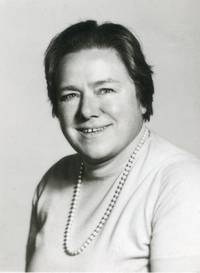


From 1953 to 1984 Lieselotte Feikes worked at Freudenberg in Weinheim an der Bergstrasse. On behalf of the company, she developed, among other things, a cleaning process for tannery wastewater. For this she received the Federal Cross of Merit at the end of her professional Career .
Lieselotte Feikes was born in 1923 in the small town of Viersen near Düsseldorf. After the early death of her father Josef, who had worked as a private tutor, she grew up with her sister in a women's household, which was strongly influenced by the friendly nature of the mother. Even while she was still at school, she was very interested in mathematics, but the subject was too dry for her to study. In chemistry, on the other hand, she was interested in experimenting.
After graduating from high school in March 1942, she wanted to study chemistry. But after graduating from school, she first had to do Reich Labor Service. It was not until the summer semester of 1943 that she was able to enroll in chemistry at the University of Halle thanks to the support of relatives. Your most important academic teacher was the later Nobel Prize winner Karl Ziegler (1898-1973). After only three semesters, Feikes had to interrupt her studies in the summer of 1944 because lectures were no longer held due to the war. In the following months she was employed as a laboratory assistant in the war effort at the chemical institute of the University of Halle. In October 1944 she became a laboratory assistant with Margot Goehring (later married Becke-Goehring, 1914-2009).
After the end of the war Feikes initially returned to her homeland in Viersen, but from there applied again for a job with Goehring, who meanwhile taught and researched at the University of Heidelberg. She was accepted and studied chemistry from 1946 to 1953 with the minor subjects physics and geology at Heidelberg University. During her studies she worked as an assistant in the analysis department at the chemical institute.
Feikes received her doctorate in 1953 for her dissertation entitled ?On the conversion between polythionate ions and hydrogen sulfide?. During the graduation ceremony she was recommended to drop by Karl Freudenberg (1886-1983), the director of the Institute for Organic Chemistry. He found her a job at the family-owned Carl Freudenberg & Co. KG in Weinheim an der Bergstrasse. The company emerged from a tannery, but was already producing seals and nonwovens back then. Household items from the Vileda brand are among the company's best-known products.
Feikes worked for the Carl-Freudenberg-Werke in Weinheim from the end of July 1953, initially on a trial basis for three months. The then 29-year-old chemist mainly dealt with the analysis of the wastewater generated in the company. After the probationary period, she asked for a permanent position. In her application she wrote: ?The work is still in full swing, and I really enjoy working here in the laboratory!? Hans Freudenberg (1888-1966), a member of the Freudenberg Group's management at the time, recognized her scientific potential and offered her continued employment.
Feikes worked in the company's leather laboratory from November 1953 to May 1973, which she also managed from 1969. In addition, she was given the task of cleaning the tannery wastewater at the company's Weinheim and Schönau sites, which represented a considerable burden for people and the environment - but also because Freudenberg started a tanning process with chromates instead of vegetable substances in the early 20th century had developed. Feikes designed a multi-stage process (mechanical-chemical-biological) for cleaning the tannery wastewater, which was used in two of the company's new sewage treatment plants in Weinheim and Schönau. She also contributed her expertise to the later construction of the Freudenberg Group's sewage treatment plants in France, Brazil and Mexico. From the beginning of the 1970s Feikes was responsible for the entire environmental protection of the Freudenberg Group. In 1983 she wrote the widely acclaimed book ?Ecological Problems of the Leather Industry?.
Feikes was awarded the Federal Cross of Merit in August 1985 for her services to environmental protection and wastewater treatment. In May 1979 she had already received the annual prize of the Association for Tannery Chemistry and Technology for her contribution to solving the environmental problems of the leather industry. In 1984 she was made an honorary member of the Association of Austrian Leather Technicians and in 1989 that of the Association for Tannery Chemistry and Technology.
Feikes retired in January 1984, but worked in an advisory capacity for the Freudenberg Group until 1991. So she remained the company's environmental protection officer until 1987. Lieselotte Feikes died on January 29, 2008 in Weinheim at the age of 84.
(Assistance: Dr. Michael Horchler, Head of Corporate Archives / Freudenberg Group)
a notice
The texts published in this series do not claim to be scientific publications. Authors and other people involved are not experts in the history of science. The purpose of the series is to introduce the mostly unknown women chemists and to remind you of the well-known women chemists. We encourage readers who want to know more to study academic Literature on the women featured. In some cases there are detailed chemical-historical works.
authors
Prof. Dr. Eberhard Ehlers
Prof. Dr. Heribert Offermanns
Editorial processing
Dr Uta Neubauer
project management
Dr Karin J. Schmitz (GDCh public relations)
The authors are responsible for the content of the biographies.
The content presented on these pages has been carefully compiled. However, the authors, Editorial staff and publishers assume no responsibility or liability for the completeness and correctness of the content or for typographical errors.
Photo: Freudenberg & Co. KG, company archive
back to overview biographies of women chemists
back to publications
This page has been machine translated. If you have any feedback or comments please feel free to contact us. 
last modified: 28.05.2021 13:15 H from K.J.Schmitz